
Appropriate PPE is fundamental to the success and safety of the workplace. Whether it be in a warehouse or working remotely on the road, all workplaces pose hazards that can be minimised by appropriate workwear. One of these many functional workwear items are Coveralls. Coveralls are a multifunctional item of PPE that provide protection and comfort against many types of hazards in the workplace. Some of these include:
- Sparks
- Spills
- Weather
- Sharp objects
Coverall Benefits:
- Clothing protection – Whether you’re changing the oil in the car or you’re welding up a crankshaft, coveralls provide the protection your underclothes require. As it’s important to have the right tool for the job, this too applies to your coverall selection. They range in material type, shape, thickness, and can be chosen specifically for what your needs are.
- Visibility – Coveralls can provide additional visibility through the application of high-visibility colours and reflective tape. To assist others in the increased visibility of team members, the application of high-visibility colours and reflective tape can keep the worker safe, especially in low-light or adverse weather conditions.
- Weather protection – Those that work outside can benefit from the coverage protection that coveralls provide. Whether it be exposure to the sun or decreased temperatures, appropriate selection of coveralls can mitigate these sometimes-hostile conditions.
- Skin protection – Most important of all is skin protection. Coverall offers the great advantage of covering the exposed skin of the worker’s body, protecting them from spark, flames, chemicals and other hazardous materials. That is why a majority of industries keep coveralls as their standard operational uniform.
Fabric Types:
Fabric plays a substantial role in the making of coveralls. Generally, coveralls are manufactured using two types of materials:
- Polyester/ Cotton Blend
It is one of the most used materials in the making of coveralls. Polyester hugely enhances the fabric's durability and offers better colour fastness than 100% cotton. Apart from that, polyester provides good resistance to some chemicals, such as battery acid, making it suitable for industrial work. - 100% Cotton
Conversely, 100% cotton is another great alternative to polyester coveralls. It is soft, breathable, and highly comfortable to wear. 100% cotton coveralls are usually worn by workers who work at coal mines and other industries where the heat effect is high. Coveralls made with cotton are easy to maintain and are durable enough to be industrial laundered.
Types of Workwear Overalls & Coveralls:
Coveralls are not the only type of protective PPE clothing that a worker can wear. There are also:
- Coveralls/Overalls– These are one-piece safety uniforms that cover the body from the neck to the ankle region. They protect the wearer from dirt, sparks, and other hazardous elements that can harm a worker. Some overalls also include a hood that can be worn over the head to protect it from heat, cold, debris, and more.
- Roughalls – They are loose-fitting pairs of pants that are supported with cross straps from the neck region. Roughalls are usually sleeveless and workers can wear them over regular shirts and vests.
Choosing the right Coverall:
What to look out for when choosing the right pair?
- Does it meet the correct Australian Standards for the purpose that you require? By ensuring that your choice meets these standards, you are ensuring better protection and a better-quality product. These standards are:
- AS/NZS 4602.1:2011 – High Visibility – To meet this Standard, the garment must include a certain pattern option of reflective material. This ensures a minimum luminance for safety. This can be broken down into three classes:
-
-
- Class D – Daytime use.
- Class N – Night-time use.
- Class D/N – Day and night use.
-
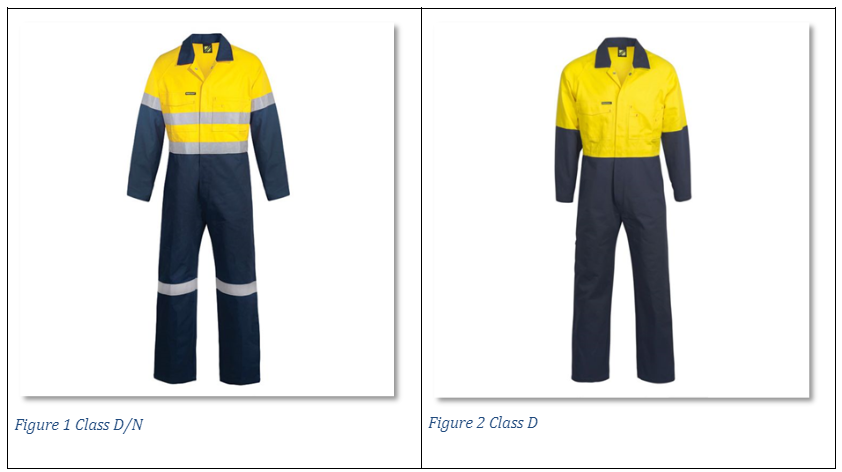
-
- AS/NZS 1906.4:2010 – Retroreflective materials and devices for road traffic control purposes. This Standard specifies the photometric, colormetric, and physical property requirements for high-visibility materials for outdoor daytime use
- AS/NZS 1020:1995 – Water and Humidity – To meet this Standard, the garment, under particular conditions, will not allow water to pass through it for a set amount of time. This is broken into two categories:
-
-
-
- X – Water Penetration Resistance.
- Y – Breathability
-
- Material choice – Whether it be cotton, polyester, or nylon, be sure to pick what is right for your needs. For a more robust fabric that is heavy weight and durable due to the twill weave, is a cotton drill. Perfect for structured garments such as workwear and is perfect for Coveralls.
-
Affordable and Durable Cotton Overalls:
Hi Vis Two Tone Cotton Drill Coveralls
Along with the highlights listed on the right, some of the compliance key features are:
- Class D – Day use only.
- UPF Rating 50.
- Suitable for industrial laundry.
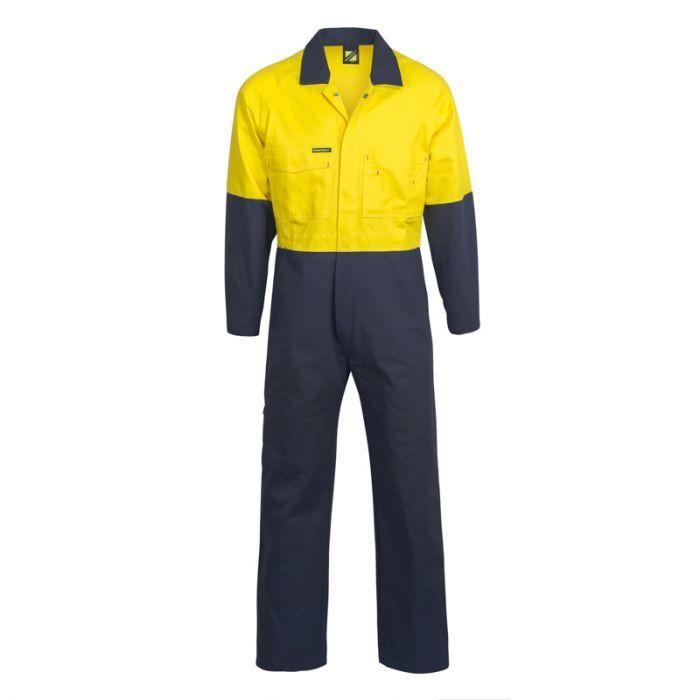 |
Highlights
|
Hi Vis Cotton Coveralls With Reflective Tape
Along with the highlights listed on the right, some of the compliance key features are:
- Class D/N – Day/Night use.
- UPF rating 50.
- CSR reflective tape 100 wash.
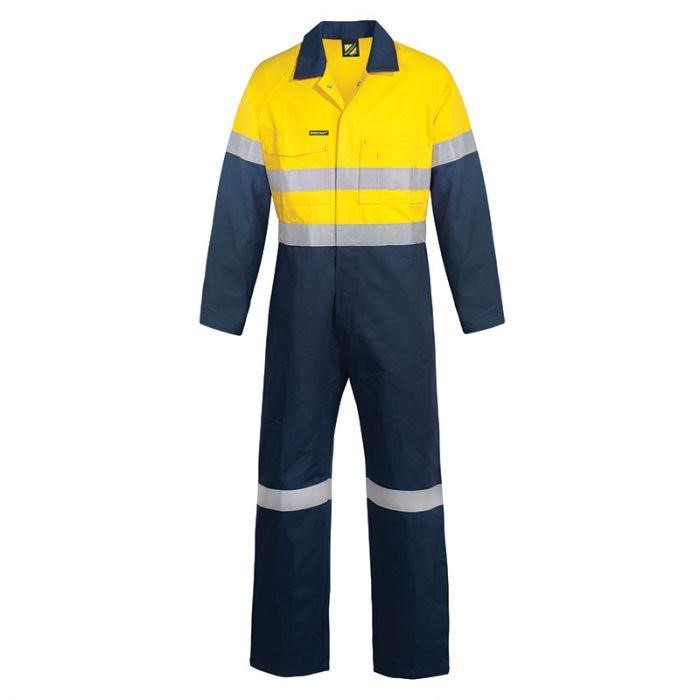 |
Highlights
|
Cotton Drill Coveralls
Along with the highlights listed on the right, some of the compliance key features are:
- UPF Rating 50.
- Suitable for industrial laundry
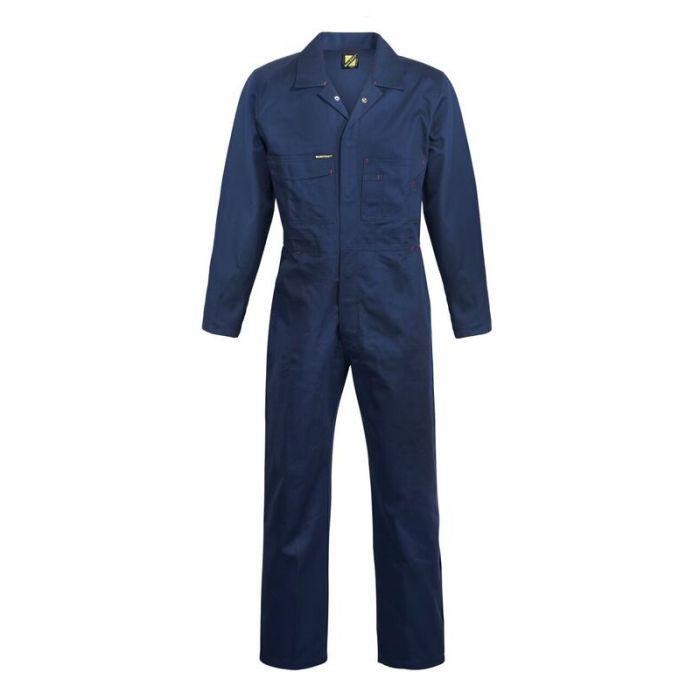 |
Highlights:
|
Two Tone Cotton Roughall
Along with the highlights listed on the right, some of the compliance key features are:
- UPF Rating 50.
- Suitable for industrial laundry
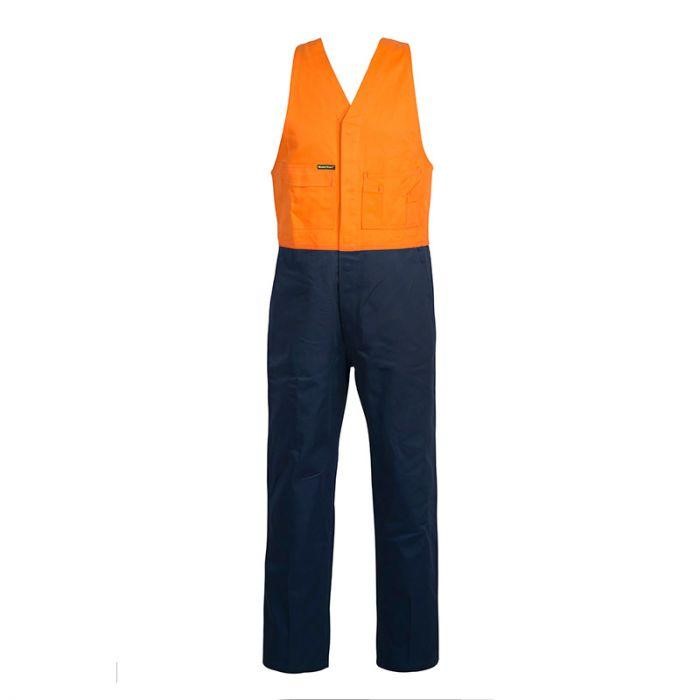 |
Highlights:
|
Hi Vis Cotton Coverall With Bio Motion Tape - Night Use Only
Along with the highlights listed on the right, some of the compliance key features are:
- Class N – Night use only.
- UPF Rating 50.
- CSR reflective tape 100 wash.
- Biomotion
 |
Highlights:
|
FAQ:
How do I know what coveralls to purchase?
- First, ascertain what you need them for? This will assist in deciding what material you want.
- Protection from what? Full body or a focus on the legs and torso.
- Are there compliance standards that need to be met for the task? e.g. Sunlight, waterproofing, etc.
What size do I purchase?
- For the most accurate sizing indication, ensure you measure your exact measurements. This includes your bust, natural waist, low waist, and hips.
- Have someone assist you in measuring.
- Ensure that you measure over under clothes.




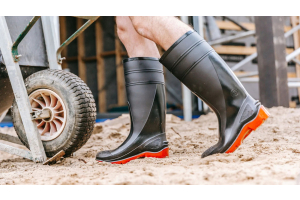
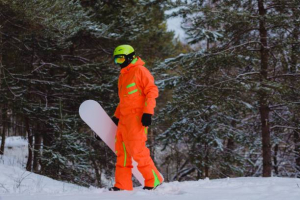
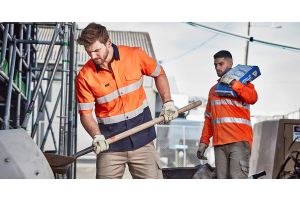
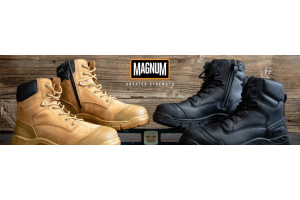

Please complete your information below to login.
Sign In
Create New Account